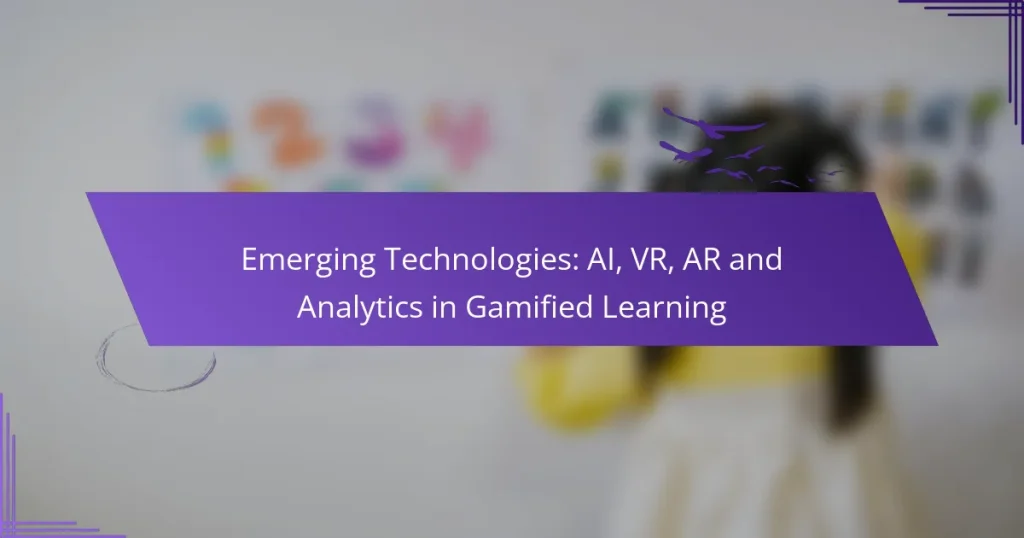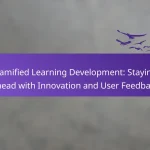Emerging technologies such as AI, VR, AR, and analytics are revolutionizing gamified learning by creating more engaging and personalized educational experiences. AI enables tailored content that adapts to individual learner needs, while VR and AR immerse students in interactive environments that enhance understanding of complex concepts. Together, these technologies foster a dynamic learning atmosphere that promotes both effectiveness and enjoyment in education.

How is AI transforming gamified learning?
AI is significantly transforming gamified learning by enabling personalized and adaptive educational experiences. Through advanced algorithms, AI tailors content to meet individual learner needs, enhancing engagement and effectiveness in educational settings.
Personalized learning experiences
AI creates personalized learning experiences by analyzing student data to identify strengths and weaknesses. This allows educational platforms to customize content, pacing, and challenges based on each learner’s unique profile. For example, a student struggling with math concepts may receive additional practice problems tailored to their specific difficulties.
By leveraging machine learning, these systems continuously adapt as students progress, ensuring that learning remains relevant and engaging. This approach not only boosts retention but also fosters a sense of ownership in the learning process.
Adaptive assessments
Adaptive assessments powered by AI adjust the difficulty of questions based on a learner’s performance in real-time. This dynamic approach ensures that students are neither bored with overly simple tasks nor overwhelmed by excessive challenges. For instance, if a student answers several questions correctly, the system may present more complex problems to further test their understanding.
Such assessments provide immediate feedback, allowing learners to identify areas for improvement quickly. This timely response helps maintain motivation and encourages a growth mindset, as students can see their progress and areas needing attention.
Enhanced engagement through AI tutors
AI tutors enhance engagement in gamified learning by providing instant support and guidance. These virtual assistants can answer questions, offer explanations, and suggest resources tailored to individual learning paths. For example, an AI tutor might recommend specific games or activities that align with a student’s interests and learning objectives.
Additionally, AI tutors can track student interactions and adapt their responses accordingly, creating a more interactive and responsive learning environment. This level of engagement can lead to improved learning outcomes and increased student satisfaction.
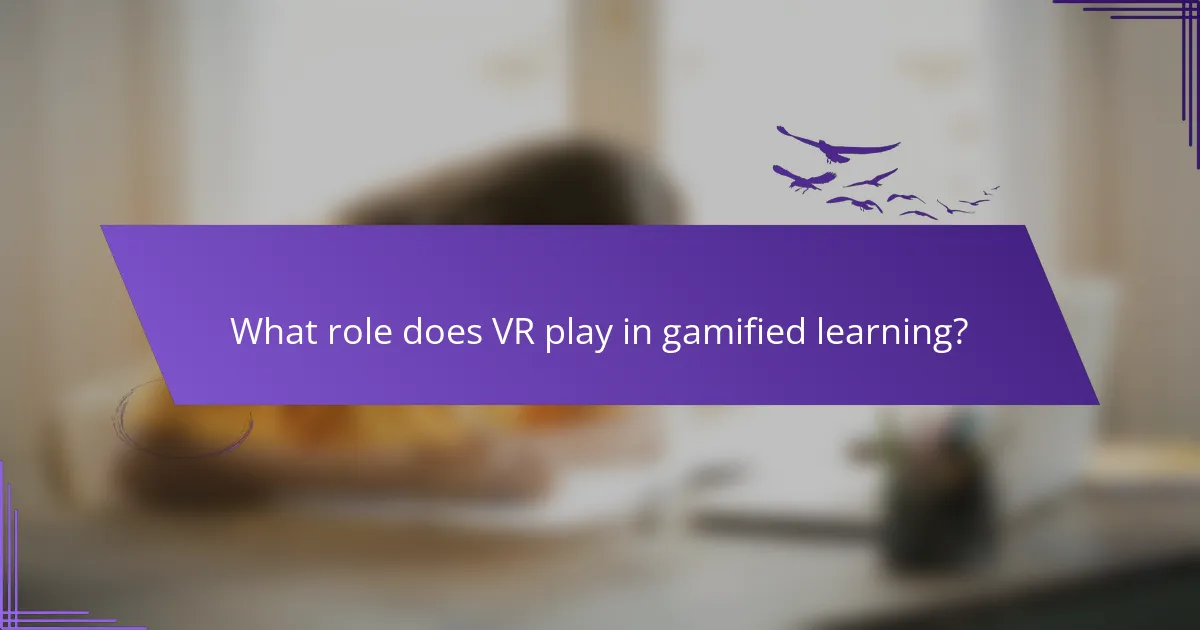
What role does VR play in gamified learning?
Virtual Reality (VR) enhances gamified learning by creating immersive environments that engage learners in interactive experiences. This technology allows users to explore complex concepts and scenarios in a controlled setting, making learning more effective and enjoyable.
Immersive simulations
Immersive simulations in VR provide learners with realistic experiences that mimic real-life situations. These simulations can range from virtual laboratories for science experiments to simulated flight training for pilots. By engaging multiple senses, VR helps learners retain information better and apply it in practical contexts.
When designing immersive simulations, consider the level of interactivity and realism required. High-quality graphics and responsive controls can significantly enhance user engagement. However, ensure that the technology is accessible and does not overwhelm learners with complexity.
Real-world scenario training
VR is particularly effective for real-world scenario training, allowing learners to practice skills in a safe environment. For example, medical students can perform virtual surgeries, while emergency responders can simulate crisis situations. This hands-on approach builds confidence and competence without the risks associated with real-life practice.
To maximize the benefits of real-world scenario training, incorporate feedback mechanisms that guide learners through their actions. Regular assessments can help identify areas for improvement. Additionally, consider the duration of training sessions; shorter, focused sessions are often more effective than lengthy ones.

How does AR enhance gamified learning?
Augmented Reality (AR) enhances gamified learning by creating immersive experiences that combine digital content with the real world. This technology engages learners through interactive elements, making education more dynamic and effective.
Interactive learning environments
AR transforms traditional learning spaces into interactive environments where users can engage with educational content in a hands-on manner. For example, students can visualize complex scientific concepts by interacting with 3D models overlaid on their physical surroundings. This approach not only boosts engagement but also aids in better retention of information.
To implement AR in gamified learning, educators can utilize platforms that allow the creation of AR content easily. Tools like Zappar or Aurasma enable the integration of AR experiences into existing curricula, making it accessible for various educational levels.
Real-time feedback and guidance
One of the key benefits of AR in gamified learning is the provision of real-time feedback and guidance. As learners interact with AR elements, they receive immediate responses that help them understand their progress and areas needing improvement. This instant feedback loop encourages experimentation and enhances the learning process.
For instance, in a language learning app, AR can provide instant pronunciation feedback by analyzing the user’s speech as they practice. This immediate correction helps learners adjust their skills on the spot, leading to more effective learning outcomes.

What analytics are crucial for gamified learning?
Crucial analytics for gamified learning include performance tracking and user engagement metrics. These analytics help educators and developers understand how learners interact with gamified elements, enabling them to optimize the learning experience.
Performance tracking
Performance tracking involves monitoring learners’ progress and achievements within the gamified environment. Key metrics include completion rates, scores, and time spent on tasks. By analyzing these data points, educators can identify areas where learners excel or struggle.
For effective performance tracking, consider using dashboards that visualize progress over time. This can help in quickly assessing whether learners are meeting their goals. Regularly updating these metrics ensures that any necessary adjustments to the learning experience can be made promptly.
User engagement metrics
User engagement metrics focus on how actively learners participate in gamified learning activities. Important indicators include session duration, frequency of logins, and interactions with game elements. High engagement often correlates with better learning outcomes.
To enhance user engagement, track patterns in how learners interact with the content. For instance, if certain game features are underused, it may indicate a need for redesign or additional support. Setting benchmarks for engagement can help in evaluating the effectiveness of gamified strategies.
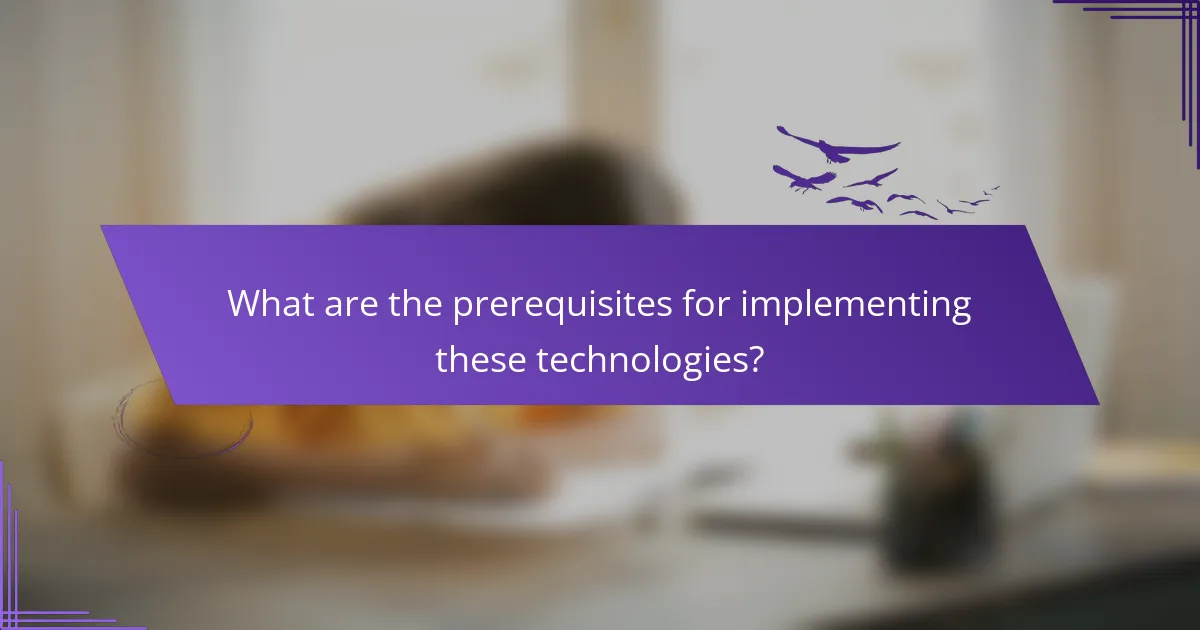
What are the prerequisites for implementing these technologies?
To effectively implement AI, VR, AR, and analytics in gamified learning, organizations need a solid technical infrastructure and skilled content development expertise. These prerequisites ensure that the technologies function seamlessly and deliver engaging educational experiences.
Technical infrastructure
A robust technical infrastructure is essential for integrating emerging technologies into gamified learning. This includes reliable hardware, such as VR headsets and AR-capable devices, as well as sufficient bandwidth to support high-quality content delivery. Organizations should consider cloud services for scalability and data storage, ensuring they can handle increased user loads and analytics processing.
Additionally, compatibility with existing systems is crucial. Organizations should assess their current Learning Management Systems (LMS) and ensure they can integrate with new technologies. Regular updates and maintenance are necessary to keep systems running smoothly and securely.
Content development expertise
Content development expertise is vital for creating engaging and effective gamified learning experiences. This requires a team skilled in instructional design, game mechanics, and multimedia production. Understanding how to blend educational content with interactive elements will enhance learner engagement and retention.
Organizations should invest in training for their content developers to stay updated on the latest trends in gamification and technology. Collaborating with subject matter experts can also ensure that the content is accurate and relevant, which is critical for educational effectiveness.

What are the best platforms for gamified learning?
The best platforms for gamified learning effectively engage users through interactive elements and game mechanics. They enhance the educational experience by making learning enjoyable and motivating, often incorporating features like quizzes, leaderboards, and rewards.
Edmodo
Edmodo is a social learning platform that allows educators to create a collaborative environment for students. It integrates gamified elements such as badges and rewards to encourage participation and achievement.
Teachers can create assignments, quizzes, and polls, while students can earn points for completing tasks. This fosters a sense of competition and community, making learning more engaging.
When using Edmodo, ensure to set clear objectives for gamification to maximize student involvement. Regularly update content to keep the learning experience fresh and exciting.
Kahoot!
Kahoot! is a game-based learning platform that enables educators to create fun quizzes and interactive games. Users can join via a code, making it easy to engage large groups in real-time competitions.
The platform supports various question formats, including multiple-choice and true/false, and allows for customization to suit different subjects. This flexibility makes it suitable for various educational levels.
To make the most of Kahoot!, focus on crafting questions that challenge students while remaining fun. Incorporate multimedia elements like images and videos to enhance engagement and retention.
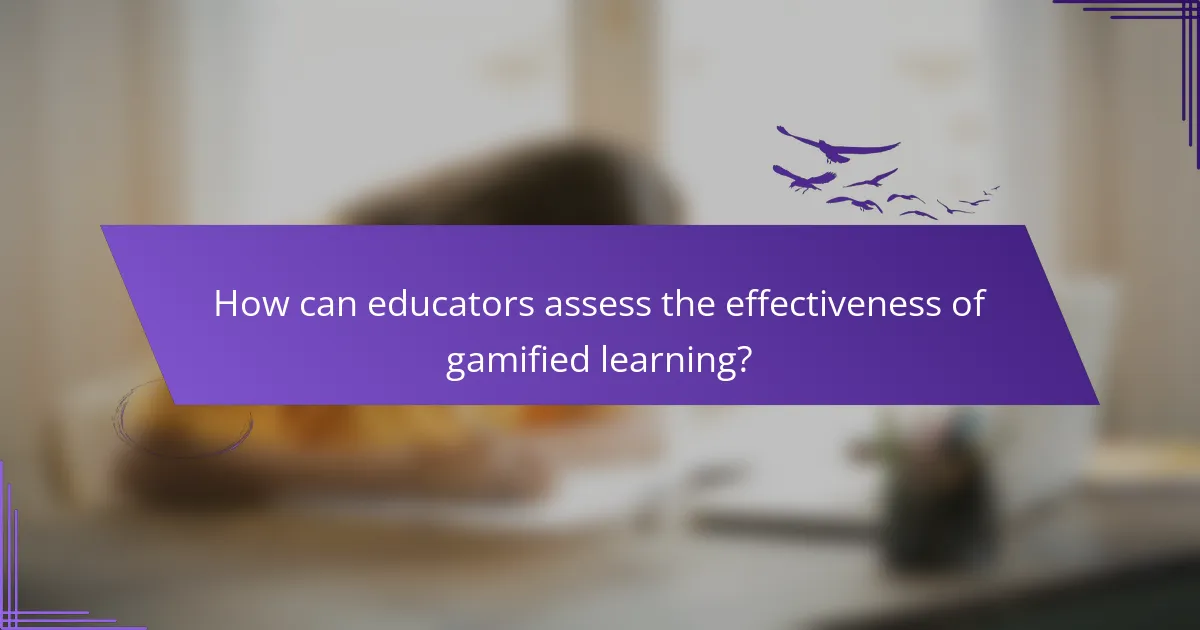
How can educators assess the effectiveness of gamified learning?
Educators can assess the effectiveness of gamified learning by analyzing student engagement, performance metrics, and feedback. Key indicators include completion rates, knowledge retention, and overall satisfaction with the learning experience.
Measuring Engagement
Engagement can be measured through various metrics such as participation rates, time spent on tasks, and interaction levels within the gamified environment. Tools like learning management systems (LMS) often provide analytics that track these metrics, allowing educators to gauge how actively students are involved in the learning process.
For instance, if a gamified module shows high completion rates but low interaction, it may indicate that students are not fully engaged. Regularly reviewing these metrics helps educators adjust their strategies to enhance student involvement.
Assessing Learning Outcomes
To assess learning outcomes, educators should compare pre- and post-assessments to measure knowledge gain. This can include quizzes, projects, or practical applications of skills learned through gamified activities. A significant improvement in scores indicates effective learning.
Additionally, formative assessments during the gamified experience can provide real-time insights into student understanding, allowing for timely interventions if necessary.
Gathering Feedback
Collecting feedback from students is crucial for understanding their perceptions of the gamified learning experience. Surveys and interviews can reveal insights into what aspects of the gamification resonated with them and what could be improved.
For effective feedback collection, consider using anonymous surveys to encourage honest responses. This qualitative data complements quantitative metrics and provides a fuller picture of the learning effectiveness.
Using Analytics Tools
Analytics tools can significantly enhance the assessment process by providing detailed insights into student performance and engagement patterns. Platforms like Google Analytics or specific educational analytics software can track user behavior and learning progress.
Educators should familiarize themselves with these tools to interpret data effectively, focusing on key performance indicators (KPIs) relevant to their specific learning objectives. This data-driven approach allows for informed adjustments to the gamified learning design.
